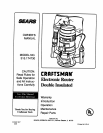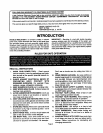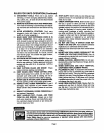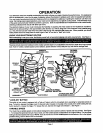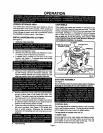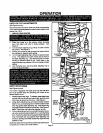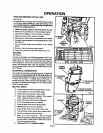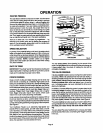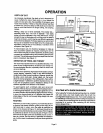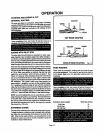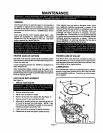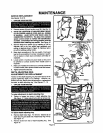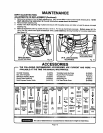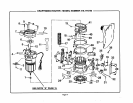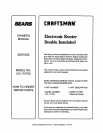
OPERATION
PROPER FEEDING
The rightfeed isneither too fast nortoo slow. It isthe rate at
whichthe bitis being advanced firmly and surely to produce
a continuousspiral of uniform chips -- without hogging into
thewood tomake large individualchips or, on the other hand,
tocreate only sawdust. If you are making a small diameter,
shallow groove in soft, dry wood, the proper feed may be
about as fast as you can travel your router along your guide
line.On the other hand, ifthe bitisa large one, the cutisdeep
or the wood ishard tocut,the proper feed may bea veryslow
one.Then, again, across-grain cutmay require a slowerpace
than an identical with grain cut in the same workplece.
There is no fixed rle. You will learn by expedence.,, by
listeningto the muter motor and by feeling the progress of
each cut. Ifat all possible, always test a cut on a scrap piece
of the workpiece wood, beforehand.
SPEED SELECTION
In general, if the material being cut is hard, the cutter size is
large, orthe depth ofcut isdeep (maximum 1/8 in.), then your
router shouldbe runat slower speeds. When these situations
exist,turnthevariable speed controlselector untilthe desired
speed is reached. NOTE: Carbide cutters cut at higher
speeds than steel cutters and should be used when cuffing
very hardmaterials.
i
RATE OF FEED
IMPORTANT:Thewhole"secret"ofprofessionalroutingand
edgeshapingliesinmakingacarefulset-upforthecuttobe
madeandinselectingtheproperrateoffeed.
FORCEFEEDING
Clean,smoothroutingand edge shapingcan be doneonly
whenthe bit is revolvingat a relativelyhigh speed and is
takingverysmallbitestoproducetiny,cleanlyseveredchips.
Ifyourrouterisforced tomoveforward toofast, the RPMof
thebitbecomesslowerthannormalin relationtoitsforward
movement.As a result,the bit musttake biggerbitesas it
revolves."Biggerbites"mean biggerchips,and a rougher
finish. Biggerchipsalso requiremore power, whichcould
resultintheroutermotorbecomingoverloaded.
Underextremeforce-feeding conditionstherelativeRPMof
thebitcanbecomesoslow--and thebitesit hastptakeso
large--thatchipswillbepartiallyknockedoff(ratherthanfully
cutoff),withresultingsplinteringandgougingoftheworkpiece.
See Figure9.
Your CraftsmanRouter is an extremely high-speedtool
(25,000 RPMno-loadspeed),and willmake clean, smooth
cutsifallowedto runfreelywithouttheovedoadofa forced
(toofast)feed.Threethingsthatcause=forcefeeding"arebit
size,depth-of-cut,andworkpiececharactedsUcs.The larger
thebitorthedeeperthecut,themoreslowlytheroutershould
bemovedforward.Ifthewoodisveryhard,knotty,gummyor
damp,theoperationmustbe slowedstillmore.
TOO FAST
Fig.9
Youcan alwaysdetect=forcefeeding"bythe soundofthe
motor.Itshigh-pitchedwhinewillsoundlowerandstrongeras
it loses speed.Also, the strainof holdingthe toolwillbe
noticeablyincreased.
TOO SLOW FEEDING
Itisalsopossibleto spoil a cutbymovingthe routerforward
too slowly.Whenit Is advancedintothe worktoo slowly, a
revolvingbitdoesnotdigintonewwoodfast enoughtotake
a bite;instead,itsimplyscrapesawaysawdust-likeparticles.
Scrapingproducesheat, whichcanglaze, burn,or marthe
cut-- in extremecases,caneven overheatthe bitso as to
destroyitshardness.
Inaddition,itis moredifficulttocontr Ia routerwhenthebit
isscraping insteadofcutttng.Withpracticallyno loadonthe
motorthe bitwillbe revolvingat closetotop RPM, andwill
havea muchgreaterthan normaltendencytobounceoffthe
sidesof the cut(especially,ifthe woodhas a pronounced
grainwithhardandsoftareas).Asa result,thecutproduced
mayhaverippled,insteadofstraightsides.See Figure9.
"Too-slowfeeding"canalsocauseyourmutertotakeoffina
wrongdirectionfromtheintendedlineofcut.Always grasp
and hold your router firmly with both hands when rout-
ing.
Youcandetect"too-slowfeeding" bythe runawaytoo-highly
pitchedsoundofthemotor;orbyfeelingthe=wiggle"ofthebit
inthecut.
Page8



